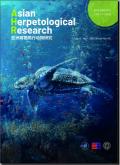澳大利亚热带地区伯顿无腿蜥蜴的生态学和行为
IF 1.2
3区 生物学
Q2 ZOOLOGY
引用次数: 12
摘要
这种长而无肢的蹼足蜥蜴(足蜥科)遍布澳大利亚,一直延伸到新几内亚南部。尽管在大多数澳大利亚生态系统中它们的多样性和丰富性,但对它们的科学研究却很少。在澳大利亚的热带北领地,对一种足足动物——伯顿无腿蜥蜴(Lialis burtonis Gray 1835)进行了深入的生态学研究。L. burtonis只吃其他蜥蜴,主要是石龙子,而且进食频率相对较低(只有20.8%的胃含有猎物)。排卵和交配主要发生在旱季后期(9月左右开始),大多数产卵发生在雨季的早期到中期(11月至1月)。雌性每年可以产下多窝卵,其中一些卵可能会与储存的精子受精。自由放养的L. burtonis是久坐不动的伏击觅食者,无线电追踪的蜥蜴平均每天移动不到5米。大多数的觅食是在白天进行的,但蜥蜴可能在白天或晚上的任何时间都很活跃。无线电追踪的蜥蜴通常在落叶微栖息地中被发现,这种偏好在使用野外围栏的栖息地选择实验中也很明显。蜥蜴通常会把自己埋在6-8厘米的垃圾中;在这个深度,它们探测到潜在的猎物,同时躲避捕食者和猎物,并避免致命的高温。本文章由计算机程序翻译,如有差异,请以英文原文为准。
Ecology and Behaviour of Burton's Legless Lizard (Lialis burtonis, Pygopodidae) in Tropical Australia
The elongate, functionally limbless flap-footed lizards (family Pygopodidae) are found throughout Australia, ranging into southern New Guinea. Despite their diversity and abundance in most Australian ecosystems, pygopodids have attracted little scientific study. An intensive ecological study of one pygopodid, Burton's legless lizard (Lialis burtonis Gray 1835), was conducted in Australia's tropical Northern Territory. L. burtonis eats nothing but other lizards, primarily skinks, and appears to feed relatively infrequently (only 20.8% of stomachs contained prey). Ovulation and mating occur chiefly in the late dry-season (beginning around September), and most egg-laying takes place in the early to middle wet-season (November-January). Females can lay multiple clutches per year, some of which may be fertilised with stored sperm. Free-ranging L. burtonis are sedentary ambush foragers, with radio-tracked lizards moving on average < 5 m/day. Most foraging is done diurnally, but lizards may be active at any time of day or night. Radiotracked lizards were usually found in leaf-litter microhabitats, a preference that was also evident in habitat-choice experiments using field enclosures. Lizards typically buried themselves in 6-8 cm of litter; at this depth, they detect potential prey items while staying hidden from predators and prey and avoiding lethally high temperatures.
求助全文
通过发布文献求助,成功后即可免费获取论文全文。
去求助
来源期刊

Asian Herpetological Research
ZOOLOGY-
CiteScore
2.80
自引率
7.10%
发文量
441
审稿时长
>12 weeks
期刊介绍:
AHR aims to provide a forum for herpetologists and related scientists interested in conducting international academic exchanges and joint studies, and a platform for introducing their newly made scientific and technological data, and publishing their research results and achievements in the world, but focusing on the Asian-Pacific Region.
The principal criteria of AHR for acceptance of articles for publication are the quality and significance of the research, breadth of interest of the work to the readership, and the clarity and effectiveness of communication. AHR welcomes submission of manuscripts from authors in all countries of the world, though with a focus on the herpetological studies in the Asian and Pacific Region, including major articles, shorter communications and review articles.
 求助内容:
求助内容: 应助结果提醒方式:
应助结果提醒方式:


